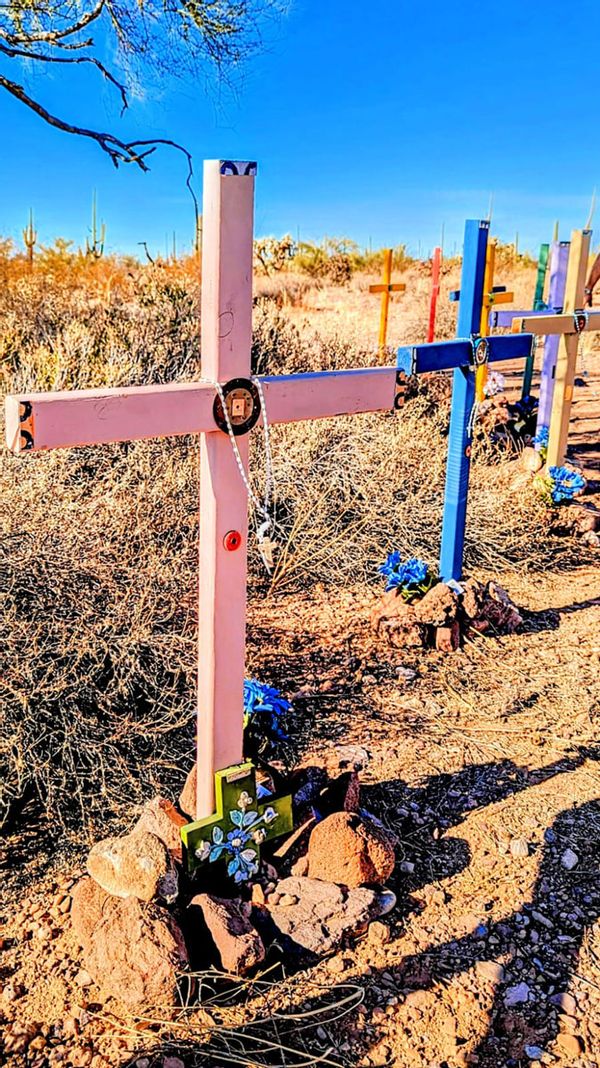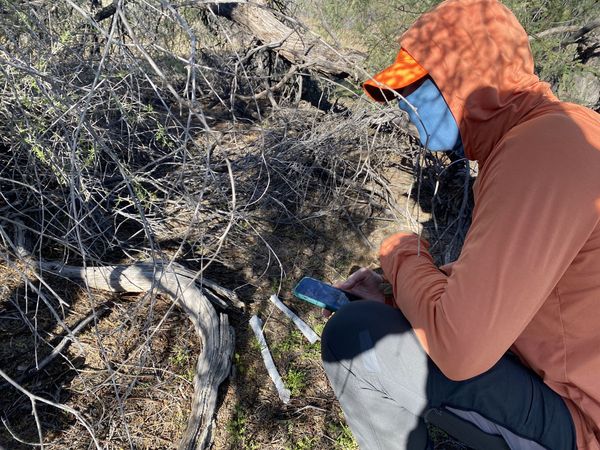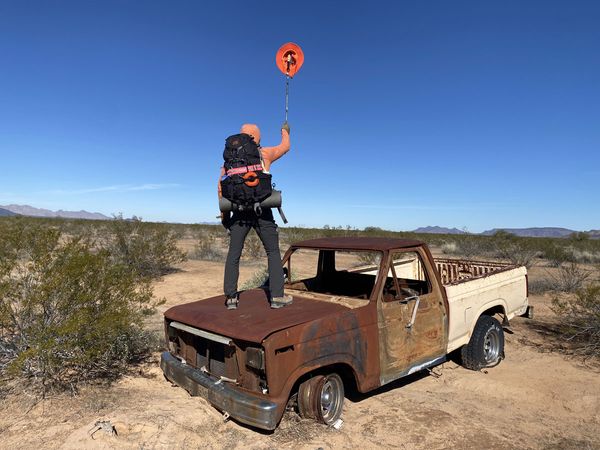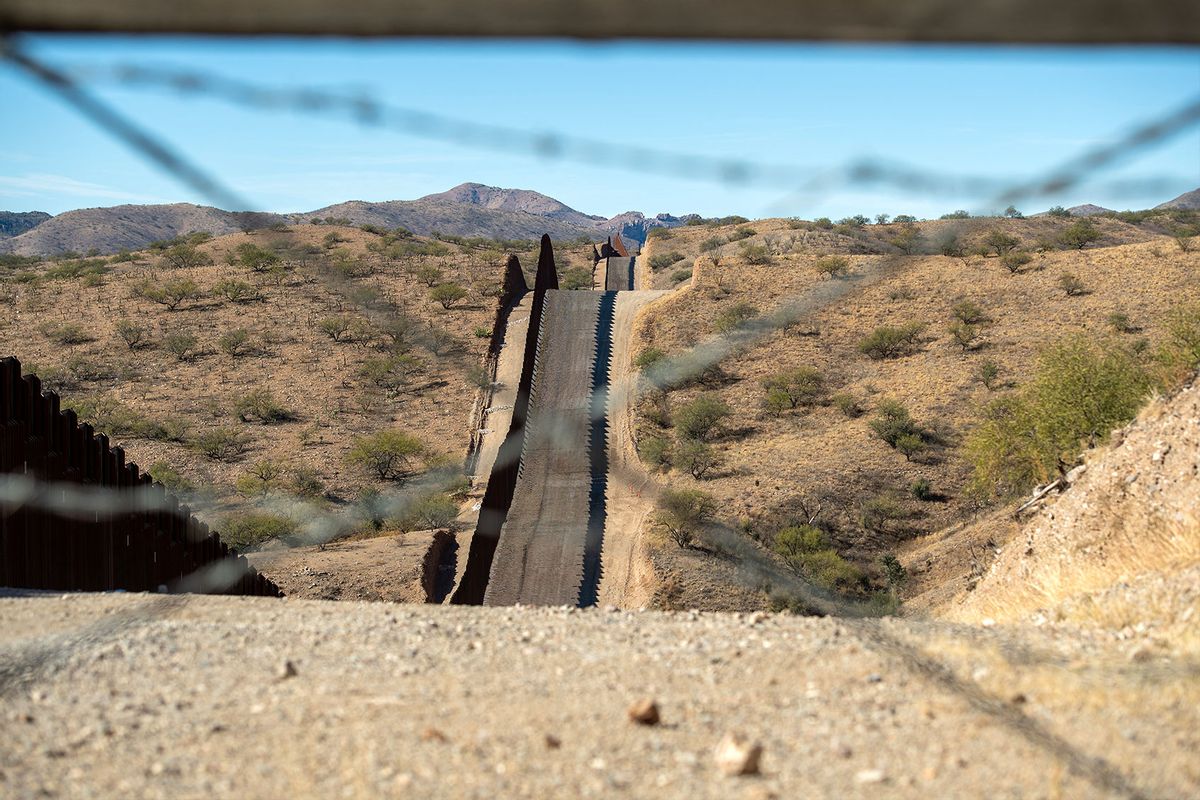When Battalion Search and Rescue discovered the scattered, skeletal remains of another body in the desert at Organ Pipe National Monument earlier this year, founder James Holeman followed usual protocol, noting GPS coordinates and taking photos, as well as marking the area with fluorescent orange tape to help law enforcement later retrieve the unidentified remains. The site is among over 100 sets of human remains Holeman has found during almost six years volunteering and eventually leading search and rescue groups for migrants on the U.S.-Mexico border.
A report from Holeman lists the remains found at this particular site, “including cranium, mandible, femur, ribs, vertebrae and more.” The report also mentions two cell phones, clothing, a lighter, hygiene items and a backpack.
According to U.S. Customs and Border Protection, 8,050 people have died illegally crossing the Southwestern border between fiscal year 1998 and 2020. Although Border Patrol hasn’t publicly reported on the number of migrant deaths since fiscal year 2021, Salon obtained CBP’s most recent report on unidentified remains, which lists a total of 895 reported migrant deaths during fiscal year 2022. Despite Border Patrol’s restrictive policies for reporting remains, this is an all-time high.
Although it is unclear why this report has not yet been made publicly available on the CBP website, Border Patrol’s record-breaking numbers of migrant encounters have meanwhile remained current, with information already available for January 2024. Given news reports of 3.2 million migrant encounters at the border last year, the documented number of people known to have died seems likely to be a significant undercount.
The bones in the desert tell another story.
 Crosses left to mark the locations where the remains of migrants who died trying to cross into the United States through the harsh conditions of the Sonoran Desert. (Photo courtesy of Battalion Search and Rescue)
Crosses left to mark the locations where the remains of migrants who died trying to cross into the United States through the harsh conditions of the Sonoran Desert. (Photo courtesy of Battalion Search and Rescue)
I accompanied Battalion Search and Rescue on a recent 32-mile hike through Growler Valley in south-central Arizona to comb the desert for human remains. Our search covered less than 1% of the approximately 650 square mile area, which itself represents only one small section of the Tucson corridor, one of the most active and deadly known areas for border crossings. During the three-day hike, we discovered seven sets of skeletal remains that forensic anthropologists later identified as human.
The group is named for the historic San Patricio Battalion, a regiment of Irish soldiers that defected during the Mexican-American War after facing anti-immigrant prejudice from their U.S. commanding officers. Battalion Search and Rescue is one of several volunteer organizations in the Southwest dedicated to recovering the remains of migrants, as well as occasionally providing lifesaving aid.
"You wouldn’t find bodies like this outside of a war zone."
“We find human remains. We report them to the local law enforcement [and] we occasionally deal with the medical examiner's office. Every step of the way we encounter resistance, intimidation, pushback, lack of cooperation, zero resources,” Holeman explained to a group of volunteers at the beginning of the hike. Volunteer groups are prohibited from gathering remains on behalf of law enforcement, as this would be considered tampering with a crime scene. However, Holeman has previously reported human remains only to find them again, still unrecovered months later.
“I know of at least half a dozen cases in this area since I've been doing this where they have not retrieved the remains after they were reported,” Holeman said. “Migrant remains receive a completely uneven response.”
“You wouldn’t find bodies like this outside of a war zone,” volunteer Brock Irish commented over walkie-talkie, one of several tools used by the group to keep in formation and from losing each other when searching areas sometimes hundreds of yards apart, along with high-visibility clothing, GPS and safety whistles. Irish is a former Marine, one of several military veterans in the group, including Holeman, as well as Neza, who joined the Mexican army at age 16 before immigrating to the United States. Although he’s now a U.S. citizen today, Neza says he crossed the border illegally multiple times when he was younger, although not through dangerous desert corridors like Growler Valley. When Neza’s brother died in the U.S., his family was originally asked to pay $14,000 to have the body sent back to Mexico City. (Neza requested that his last name not be used in this article.)
 Volunteer Brock Irish documents GPS coordinates of human remains at a site in Growler Valley. (Photo courtesy of Levi Stallings)
Volunteer Brock Irish documents GPS coordinates of human remains at a site in Growler Valley. (Photo courtesy of Levi Stallings)
“I incinerated him for $600 and drove all the way down to Mexico,” Neza said, explaining that the experience made him want to reunite other families with the remains of lost loved ones. “Seeing that happiness in my mom, I found a group doing this and I kept coming.”
Other volunteers on the hike include Aidan Auel, an Eagle Scout who works in Nogales at a shelter for migrants, and Abbey Carpenter, a former teacher who estimates that 99% of her past students were undocumented immigrants.
“The first time I came out, it was just emotional to see the trash, bottles and backpacks and bodies,” she said. “Those were my students.”
A 2021 study from the University of Arizona based on information collected from the Pima County Medical Examiner's Office concluded that almost half of the remains found have been identified as people age 29 or younger.
Dora Rodriguez is a survivor from a 1980 tragedy at Organ Pipe National Monument. While fleeing the civil war in El Salvador, 13 members of Rodriguez’s group died of exposure while crossing the border, including three of her younger sisters.
“The first time I came out, it was just emotional to see the trash, bottles and backpacks and bodies. Those were my students.”
Rodriguez recounted her experiences at a recent church service in Silver City, New Mexico, commenting on the numbers of dead.“Our people have been pushed to the most remote areas finding safety, and that’s why our numbers in the borderlands in the Arizona area are over 5,000 people — and these are only the people that have been found.”
Border Patrol officials did not respond to Salon’s questions, including emailed inquiries about how CBP collects and publishes data on migrant deaths. A page on the CBP website explains the difference between official statistics and numbers of migrant deaths reported by outside groups: “While CBP works hard to track this information as fully and accurately as possible, these data are not all encompassing. These numbers may differ from other organizations that track similar data.”
By Rodriguez’s estimate to the Silver City congregation, the real numbers “are probably five times more.”
Humane Borders mapping coordinator Mike Kreyche maintains and updates the Migrant Mortality Map, the most comprehensive public database created for keeping track of sites where remains have been found near the U.S.-Mexico border. Working with limited information, the project only accounts for remains found within Arizona.
“That’s a death march through there,” Kreyche told Salon, specifically referring to Growler Valley. “It seems that every time people go out there, they find evidence of deceased migrants.”
Crossing the U.S. border through Growler Valley requires migrants to walk through at least 60 miles of harsh desert. The wild landscape is littered with abandoned objects like backpacks and empty water bottles, as well as materials found from the nearby Goldwater Bombing Range. This includes high-caliber shells and large metal markers with flared edges sticking out of the ground that the group refers to as “darts,” which have been dropped from aircraft during military exercises. On our first night camping in the desert, a Border Patrol surveillance drone flew buzzing overhead in the middle of the night.
Along with the nearby bombing range and the threat of being detained by Border Patrol, other hazards in Growler Valley include rattlesnakes and cholla cactus.
Furthermore, simply walking that far, with inadequate footwear and insufficient water, can be deadly. “Many are dying of blisters — this is the No. 1 cause of death in the desert,” Rodriguez explained to the Silver City congregation. Left unable to walk, stranded migrants may die within a few hours.
“The desert, by design, erases people,” Holeman said. “Give it 10 years, you’re scattered, dragged down in a coyote den.”
The majority of the Battalion’s discoveries are skeletal remains. After approximately nine months in arid environments like the Sonoran Desert, the human body will completely skeletonize. Large bones like skulls and femurs can remain intact for hundreds of years.
The Pima County medical examiner’s office in Tucson investigates more migrant deaths than any other single agency in the U.S. Greg Hess, the county’s chief medical examiner, sees greater numbers of deaths across all demographics as the weather gets warmer. “A lot of what we see is just related to the weather. If we have a really hot and dry year, we're going to find more remains because the risk of people dying is higher,” he said.
Want more health and science stories in your inbox? Subscribe to Salon's weekly newsletter Lab Notes.
During the middle of summer in Growler Valley, daytime high temperatures may exceed 110° F for weeks at a time. The lack of a clear number of officially reported migrant deaths make it impossible to know how the warming environment may have changed the fatality rate, but hotter temperatures are the single largest factor affecting death rates from month to month.
“We don't see big changes in response to stuff people want to talk about — federal policy, panic about the border, things like that,” Hess said.
Although the number of remains brought to the Pima County Medical Examiner’s Office remains relatively consistent, officially recorded migrant deaths have a history of changing, depending on how data collection policies change.
"You can’t look at death certificate data and find this population. It doesn't exist."
Between 2015 and 2019, Border Patrol accounted for less than half of the human remains reported by Pima County. During that period, remains were only officially reported when they were found by Border Patrol agents. Remains found by any other entities in the Tucson sector weren't officially counted — even after being brought to the medical examiner’s office. Today, the CBP website lists “discovery of deceased individuals by other agencies” as not reportable, as well as “remains discovered by CBP personnel.” CBP policies currently state that the agency only reports data on migrant border crossing fatalities during specific cases when officers are present at the time of death.
The process of keeping official records changed in response to the 2019 Missing Persons and Unidentified Remains Act, which requires CBP to make annual reports on the number of migrant deaths. CBP has not released a public report on migrant deaths since fiscal year 2021, and did not respond to Salon’s questions about that apparent failure to follow the law.
CBP’s 2023 congressional report, obtained by Salon, accounts for 142 migrant deaths in the Tucson sector, while during the same fiscal period the Pima County medical examiner reported 179, suggesting that even by the most recent CBP reports, a serious undercount continues. According to CBP’s congressional report, fiscal year 2022 was the most lethal year on record for migrants. No report of migrant deaths during fiscal year 2023 has yet been made.
An April 2022 report by the Government Accountability Office found that “Border Patrol has not collected and recorded, or reported to Congress, complete data on migrant deaths, or disclosed associated data limitations.”
There are many reasons why a migrant’s body may fail to be recorded by Border Patrol.
 Volunteer Brock Irish signals location to other members of the Battalion searching a half mile away. (Photo courtesy of Levi Stallings)
Volunteer Brock Irish signals location to other members of the Battalion searching a half mile away. (Photo courtesy of Levi Stallings)
A body found near the border “goes through multiple hands,” explained Kreyche. “Somebody finds the remains, they report it to authorities, and that could be the sheriff's office, that could be the Border Patrol. It could be the tribal police, it could be a ranger in the National Park Service or the national forest. Sometimes the sheriff's deputy will be coming out to collect the remains, sometimes somebody from the medical examiner's office is called out. So there's a lot of ways for data to get passed on incorrectly.”
Recovering remains found in the desert is outside of CBP jurisdiction and always conducted by local law enforcement, even in cases where reports are made directly to Border Patrol. Along with multiple layers of reporting conducted before official counts are made, the number of migrant deaths is difficult to study even from an outside medical perspective.
“There’s nothing in the standard U.S. death certificate that would let you pull out the circumstance under which one of these people died,” Hess said, explaining the lack of medical records for border crossing deaths. “That's not a checkbox. You can’t look at death certificate data and find this population. It doesn't exist.”
Groups like Battalion Search and Rescue help local law enforcement find remains that would otherwise go uncounted by Border Patrol. Still, volunteers understand their efforts are far from giving a complete recording of the true number of people who have died crossing the border.
We need your help to stay independent
Riding in a pair of pickup trucks after our hike through Growler Valley was over, the group returned to nearby Organ Pipe National Monument, where remains had been found a week earlier within a quarter-mile of the road. Holeman’s truck is painted in inverse Border Patrol colors: teal with a white stripe in the middle. A flag waving from the back overlays stars and stripes onto a red, white and green tricolor, with the Mexican coat of arms depicting a golden eagle devouring a rattlesnake in its center.
At first, volunteers could not find the remains using headlamps as the evening grew darker. Perhaps they had been fully collected. But on closer examination of the site, a single long, thin human bone was found. Despite official recovery, the remains of someone who died here had not been fully retrieved.
“You can walk right by stuff,” said Holeman earlier during the hike. “Can you imagine if there was a concerted effort?”
Although remains found by volunteer groups like Battalion Search and Rescue are not officially counted by Border Patrol under current policies, any recovered by law enforcement and brought to the Pima County medical examiner will be added to the Humane Borders Migrant Mortality Map, with a red marker listing name, gender and cause of death whenever possible. But it is often impossible to identify people who have died in the desert, or the exact circumstances of their death. Kreyche remains acutely aware of the large gaps in mapping data.
“Nobody really knows how many we don’t know about,” he said. “We don’t know what we don’t know.”

Shares